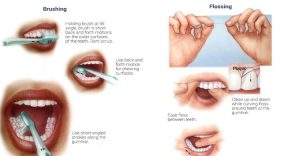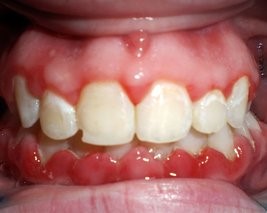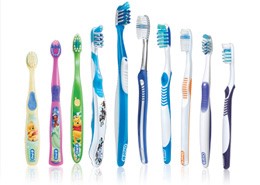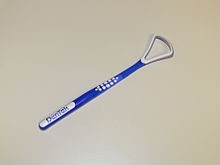Oral Hygiene Basics
What is oral hygiene?
Oral hygiene is defined as the practice of keeping one’s mouth clean and disease free by brushing and cleaning in between the teeth. This must be accomplished regularly in order to prevent disease and keep your breath fresh. Dental disease includes both dental caries (tooth decay) and gingivitis or periodontitis (gum disease).

Photo courtesy of smile and profile.net
Ideally it is best to clean your mouth after each meal, however guidelines suggest a minimum of twice daily. Once after breakfast and once before you go to bed. It is extremely important to not only brush properly (as demonstrated in the above diagram) but to clean interdentally as well. Proper oral hygiene practice in between regular dental visits can help reduce plaque and tartar buildup. This is accomplished with the use of floss or interdental aids. Brushing alone only removes approximately 50% of plaque.
What is plaque?
Plaque is a sticky yellow biofilm consisting of a wide range of bacteria found in the mouth especially along the gumline. This will continue to re-appear in your mouth even after effective brushing and flossing. Sugar in our diet encourages the formation of plaque. That is why it is important to maintain a well-balanced diet low in fermentable carbohydrates. Plaque converts sugars to acid which contributes to tooth decay by breaking down the tooth structure. Leaving plaque undisturbed on the tooth and around the gum line not only increase your chance of decay but can lead to inflammation and bleeding. The gums will appear red and swollen indicating inflammation and poor oral hygiene.

Photo courtesy or oracare products.com
Manual Toothbrush
Manual toothbrushes consist of a long handle attached to a head made of nylon bristles. The long handle allows the user to reach far back into the mouth to the last erupted tooth while the nylon bristles help to effectively remove plaque. A small head and soft bristles are highly recommended by dental professionals. Manual toothbrushing can be effective when done properly. It is important to angle the brush at a 45-degree angle towards the gumline and to move the bristles in a circular motion. This technique is crucial in plaque removal and disease prevention.

Electric Toothbrush
Electric toothbrushes consist of a plastic handle and a replaceable moving head. There are two main types, a sonic or vibrating head and an oscillating-rotating bristle head. Both of the brushes come with the option of bristle type and head size. Small head and soft bristles are still highly recommended by dentists and dental professionals alike. The sonic toothbrushes vibrate at a very high frequency creating a fluid turbulent activity. The rotating (constant clockwise and anti-clockwise movements) reduces plaque in a similar action to a manual toothbrush. Both brushes movements help to break up the chains of bacteria up to 5mm below the gumline. They also reduce the complexity of the brushing technique making it a better option for small children and adults with limited or poor dexterity.
Dental Floss
Brushing alone only removes approximately 50% of dental plaque. Flossing is essential in removing plaque in between the teeth and below the gum-line. 80% of plaque can be removed with dental floss according to the American Dental Association. There are three different types of floss available; waxed, unwaxed and Teflon. The type of floss used is a personal preference. However, it is imperative your technique is right in order to effectively remove plaque. Floss threaders, flossetts, and interdental brushes can be used in place of or in conjunction with floss for those with poor dexterity.
Tongue Scraper
Our tongue contains numerous areas for debris and bacteria to hide which causes bad breath. Tongue scrapers are designed to reach far enough to the back of the tongue and gently scrape forward removing the debris. It is made of plastic and can be rinsed off and cleaned between each use. A toothbrush can also be used, however sometimes the bristles are too soft and are ineffective. A tongue scraper can also reduce the risk of gagging in patients with a strong gag reflex.
